Corn at the VE to V3 Stage; Spray Tank Cleaning; Pale Corn; and Soybean Seedling Diseases
BY Dairyland Seed Agronomy Team
ROOTS AND PLANT GROWTH VE TO V3
As our growing season is progressing and depending on planting dates, we have corn that is either just germinating or is soon approaching 3-4 leaf, or V3 to V4. As was discussed in previous Dairyland Seed Agronomy Updates, it takes roughly 100-150 Growing Degree Units (GDU’s) for the Coleoptile to emerge from the soil.
|
Plant / Leaf Stage |
Growth Stage |
GDU's |
|
Germination |
|
10 to 20 |
|
Radicle Root Emergence |
|
30 to 40 |
|
Coleoptile Emergence Seed |
|
50 to 60 |
|
Seminal Root Emergence |
|
60 to 70 |
|
Coleoptile Emergence Soil |
VE |
100 to 150 |
|
First collar on emerged leaf |
V1 |
150 to 190 |
|
Collar on second Leaf |
V2 |
190 to 220 |
|
Collar on third leaf |
V3 |
280 to 310 |
Prior to the Coleoptile emerging the soil surface and starting between 60-70 GDU’s, the seminal root system will start to emerge from the seed and almost immediately start taking in water and nutrients for the plant to continue to grow. I normally think of the seminal root to be three individual roots much like fingers on a hand when you signal the number three. The seminal root system and the radicle will anchor the plant and act as the main root system for the plant until VE (shoot/spike coleoptile emergence) and will continue to grow until V3 (three collared corn).
Shortly after the Coleoptile emerges (VE) from the soil the first set of Nodal roots starts to emerge from the plant and by V6 (collar on sixth leaf) with additional sets of nodal root growth will become the main supplier of water and nutrients to the plant.
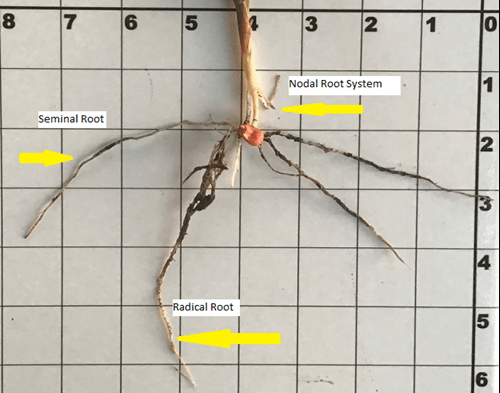
At V1 or collar on first emerged leaf, the plant is starting to utilize energy from the sun and is photosynthesizing, but is still relying on the energy of the seed to help grow. The root system on a V1 plant is normally 3 to5 inches wide and 2 to4 inches deep. As the corn plant continues to grow and reaches V2 (as the plant in the photograph shown below is very close to V2), the root system is 5 to 8 inches wide and 4 to 6 inches deep. Roots in general, except the Radicle, tend to grow out of the plant at a 25-30° angle from the horizon, with compaction and water availability impacting that as well. The Radicle can grow in any direction but reacts to gravity (Gravitropism or Geotropism) and eventually will orients itself downward in its growth pattern.
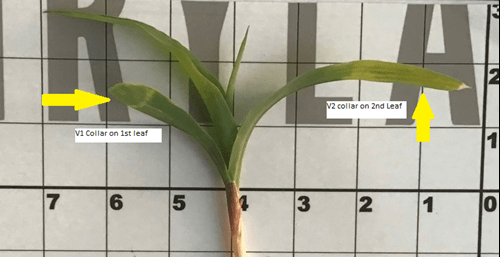
Once a corn plant reaches the V3 (collar on third leaf) growth stage, the plant is relying less on the energy of the seed and more on the leaves and the root system for its energy source. Cloudy and cool weather at this stage can cause plants to yellow up to a “Ghostbusters” yellow green slime type of color. I have always thought that a frost or two at this stage can cause more plant stand loss than earlier stages due to having more leaf tissue present that can shrivel up from the frost damage, running out of energy from the seed and subsequentially not having leaf tissue to photosynthesize and give energy to the plant.
As an aside I have always thought of the V2-V3 growth stage as the “Pre-Teenage Years” and the V5-R1 stage as the “Teenage Years”. The V5-R1 stage is also called the Grand Uptake period, which much like a teenager the plant is taking in a tremendous amount of energy (water, nutrients and sunlight) to put on growth. If you are applying additional nutrients at V2-V3 or the “Pre-Teenage” growth stage, this allows those nutrients, more time to get into the plant as the plant enters the V5 growth stage. As was stated previously, V5 is the start of the Grand Uptake period when increasing quantities of water and nutrients are needed, much like a someone entering their teenage years.
More on corn growth stages to follow in subsequent Agronomy Newsletters.
SPRAY TANK CONTAMINATION CONCERNS
We are that point in the growing season where we have transitioned from spraying pre- emergence soybean herbicides, to spraying post emergence corn herbicides. As we move from spraying a pre-soybean herbicide, to spraying a post corn herbicide, remember that many soybean herbicides can cause crop injury to the corn crop. These injury symptoms can cause the dreaded “I don’t know spots”, which we see from time to time, and are often the point of discussion at locations where coffee or other beverages are partaken.
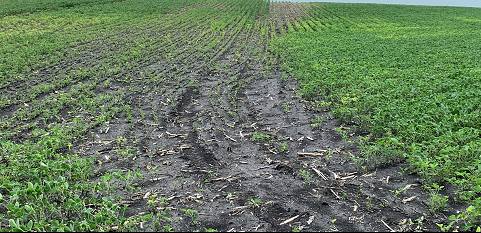
To prevent potential herbicide injury, take the time to clean and rinse out the sprayer when switching between crops. If you read the herbicide label of the product you last applied, it will provide you the proper spray tank cleaning instructions.
What I suggest is to drain the sprayer, then fill the sprayer half full with water, making sure to spray down the inside of the tank. Add a quality tank cleaner, then fill the tank to capacity with water. Agitate this mixture for 15+ minutes to flush water and tank cleaner through the spray system. (In a perfect world this is where I would shut the sprayer off and let the tank cleaner mixture sit overnight.) After this mixture has set for a period of time, drain the tank, pulling nozzles, filters and screens cleaning them separately in the tank cleaner or ammonia mixture. An area of the sprayer or spray line that is often overlooked for product that may “hang up” or have a tough time rinsing are end caps and it is best if they are pulled and cleaned as well. Rinse the tank, nozzles, filters, end caps and screens with clean water, then drain.
Remember to read herbicide labels and what the proper tank cleaning procedures are for those products. Following these instructions will help to fend off the dreaded “I don’t know spots”.
PALE CORN
In the past week, we began experiencing several color variations in corn seedlings. We are seeing a good deep green to purple to yellow. The yellow and striped corn we are observing this spring could have several causes.
The first possibility, and perhaps everyone’s knee jerk reaction, is nitrogen deficiency. Deficiency doesn’t mean there isn’t enough nitrogen applied, it may just be out of “reach” of the young roots at this time. Most of the yellow and striped corn we have dealt with is on lighter textured soils. So, we could be experiencing some leaching just beyond where the roots are growing. The other scenario is that we just don’t have our side-dress application on at this time and the plants are growing faster than nitrogen can be supplied.
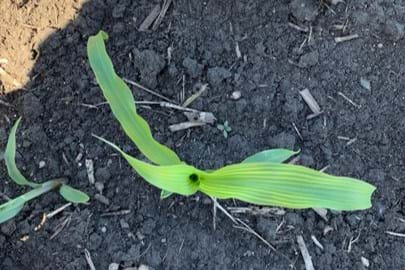
The second possible reason for yellow corn is the weather has finally become favorable for rapid vegetative growth. The yet developing permanent root system can’t keep up supplying the nitrogen need of the quick growing plant. As a result, we see the tell-tale signs of N deficiency.
Another reason for yellow striped corn, especially on lighter soils, can be Sulphur deficiency. Sulphur is mobile in the soil much like nitrogen. Heavy rains in the spring can move this nutrient out of contact with the young root system. For most of the Dairyland Seed marketing area, this was not the case. There were a few general areas that did get heavy rains and it seems to be more prevalent there. The cool conditions restricting root growth in late April and early May kept the plants from accessing what Sulphur was available.
In most all situations, more ideal growing conditions should alleviate the symptoms. In others, completion of side-dress operations, in combination with growing conditions, will snap plants into shape. In many areas, the addition of Sulphur may be warranted. If this the case, a pretty standard practice is about 20 lbs of S.
If you have further questions or concerns, feel free to contact your local Dairyland Seed Agronomist.
IDENTIFYING SOYBEAN SEEDLING DISEASES
While out early scouting in soybeans, you may notice missing plants or diseased seedlings. Common diseases like Pythium, Rhizoctonia, Fusarium and Phytophthora can reduce stands and cause significant yield loss. Soybean seedling diseases can have similar symptoms and be difficult to distinguish. There are many different species of these common diseases but the symptoms and favoring conditions differ some. By focusing on these differences, we can identify the disease affecting your field.
Pythium
There are several different species of Pythium that can affect soybeans. The best time to scout soybeans for Pythium symptoms is from the VE to V4 growth stage. Plant death usually occurs randomly or in small patches. Symptoms of Pythium are very similar to Phytophthora and can be difficult to distinguish.
Symptoms:
- Pre or post-emergence damping off and poorly developed roots
- Seedlings that emerge usually wilt and collapse and can easily be pulled out of the ground
- Water-soaked lesions are apparent on the hypocotyl or cotyledons and develop into a brown soft rot
- Stems are often soft and watery
- Older plants with severe root rot infection may become yellow, stunted or wilted
- Roots of older plants will be under developed and have a tan or brown appearance
Favoring Conditions:
- Wet conditions after planting
- Symptoms are more severe in poorly drained or compacted soils
- More common in cooler temperatures (around 55°F) but some species will thrive in warmer temperatures (60-75°F)
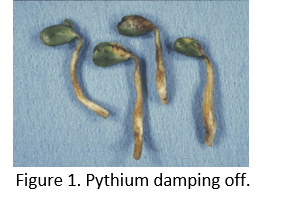
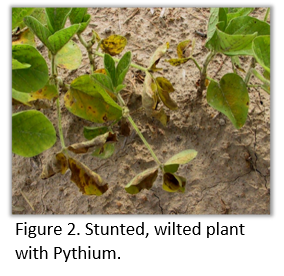
Rhizoctonia
Rhizoctonia is one of the most common soil borne disease and can infect the soybean plant anytime throughout the growing season. This disease is more severe when it infects young seedlings. Plants showing symptoms of Rhizoctonia usually show up in patches or within rows.
Symptoms:
- Characteristic symptom is localized reddish-brown lesions on the outer layer of the main root or hypocotyl near the soil line
- Pre or post-emergence damping off
- Stems remain firm and dry with sunken lesions that can girdle the hypocotyl
- Older plants with the root rot phase of Rhizoctonia will be stunted, yellow and have poor root structure
Favoring Conditions:
- Warm and moist soils but not saturated soils
- Becomes more active with warmer temperatures (around 80°F)
- Delayed plant emergence
- Nutrient deficiencies or over fertilization can increase severity
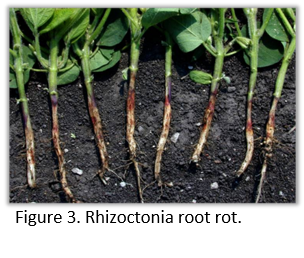
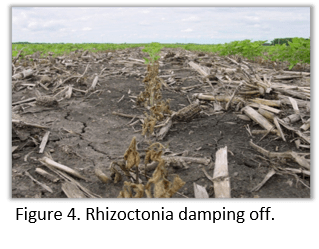
Fusarium
There are several different species of Fusarium that can infect soybean plants. These species can infect the soybean plant at any stage but are more severe in younger plants. Fusarium favors weakened or stressed plants.
Symptoms:
- Poor and slow emergence
- Seedlings may be stunted and spindly, with poorly developed roots
- Dark brown or reddish-brown to black lesions appear on the roots that are frequently sunken and dry
- Symptoms are usually restricted to the tap root and don’t appear above the soil line
- Lateral roots may die and decay
- Upper leaves may appear scorched, while the middle and lower leaves can turn necrotic, wilt and drop from the plant
Favoring Conditions:
- Species can infect during a wide variety of environmental conditions
- Associated with stressed plants
- High pH soils, compaction, nutrient deficiencies, herbicide injury or nematode feeding
- Disease can worsen after infection if soil moisture is limited
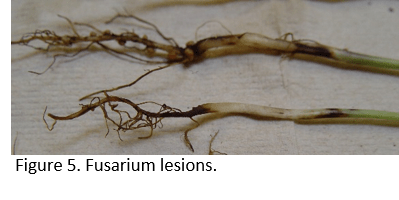
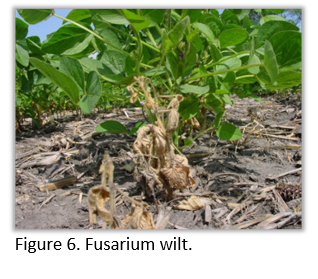
Phytophthora
There are multiple strains of Phytophthora that produce symptoms similar to Pythium. Infection usually takes place earlier in the season but symptoms can be seen from the VE to R6 growth stage.
Symptoms:
- Wilted and stunted plants
- Most characteristic symptom is the dark brown discoloration on the lower stem by the soil line that progresses up the stem
- Post-emergence damping off and rapid decay of plant tissue
- Stems of infected seedlings are mushy and appear water-soaked
Favoring Conditions:
- Wet, poorly drained or compacted soils
- Heavy rains occurring shortly after planting
- More common in warmer temperatures (around 70-80°F)
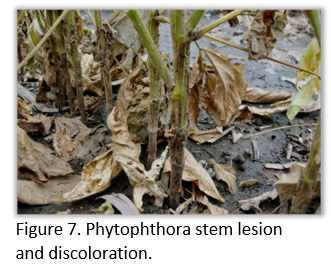
Soybean fungal pathogens can survive by overwintering in the soil and on plant debris. If you have had issues with seedling diseases in the past, chose a tolerant soybean variety and use a fungicide seed treatment. Other management practices include avoiding early planting and installing tile drains in fields with poor drainage. If you have any questions reach out to your local agronomist.
 |
 |
 |
 |
| Brian Weller Western Region 507.456.3034 |
Dan Ritter Central Region 219.863.0583 |
Branden Furseth Northern Region 608.513.4265 |
Amanda Goffnett Eastern Region 989.400.3793 |
